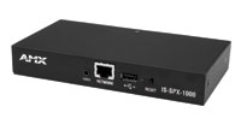Plasma display panels: form over function
Sep 1, 1999 12:00 PM,
Pete Putman
I recently completed an extensive test of six plasma display panels in mystudio. Having now tested 12 different models in one year and afterconducting a seminar on plasma technology at INFOCOMM ’99, I sometimes sitback and wonder just what it is that has created such a fuss about plasmadisplays. I am reminded of Spike Lee in those old Nike commercials in whichhe asks what makes Michael Jordan such a spectacular athlete, “Is it theshoes? It must be the shoes!”
With plasma, it must be the packaging. We finally have an electronicdisplay with which architects and interior designers can have some fun.Mount them horizontally or vertically. Fly them off the ceiling. Mix theminto panels. Pump graphics and video into them. Build walls out of them.The possibilities seem endless, but are plasma display panels (PDPs) reallythe be-all and end-all of electronic displays?
Technically, PDPs exhibit several shortcomings that make them questionablechoices to display high-quality video or work as multi-sync computermonitors. They are also fragile, and they must be handled with more carethan comparable large-screen video or computer displays. Further, they arequite expensive for what they can do; are you prepared to spend upwards of$10,000 for what amounts to a wide-screen VGA monitor with limited abilityto scale SVGA and XGA images? Even more expensive, 50 inch (1.3 m) XGApanels start just under $20,000.
Now, the upside. There are dozens of new display applications evolvingevery day simply because plasma panels exist. Imagine movie posters inwhich the image can change to show static scenes or short clips from theadvertised film. How about dynamic signs in places of public accommodation,switching between airport terminal maps and flight arrivals and departures?
Yes, I hear you saying that all of that can already be done withdirect-view monitors or rear-projection screens. The difference is thatplasma display panels do not require as much room. For the first time,there is a video and data large-screen display available that requires lessthan 6 inches (152 mm) of depth, weighs 70 pounds to 120 pounds (32 kg to54 kg) and can be wall-mounted, flown or installed in hide-away bracketswith comparative ease.
As designers and installers, you will come up against the plasma mystiquesoon. You may already have customers who want plasma simply because it isplasma. The price may be no deterrent, and the idea of being able to freeup precious floor space sounds good. These are plug-and-play devices,right? Just cable them up like any projector or monitor, hang them up, andyou are in business.
To quote a recent car rental commercial, not exactly. The physicalinstallation and cabling of plasma panels is indeed a plug-and-playscenario. They do not require much power – 120 VAC @ 3 amps to 4 amps isfine. Most models support the popular connector options, although severalnow use RCA jacks for component and RGB input, reflecting a consumer biason the part of the manufacturers. There are hardly any adjustments to make- no convergence is required; just connect the sources and turn the panelon.
That is where the trouble begins. In terms of physical packaging andaesthetics, plasma panels have got it. They represent the next generationof futuristic displays we have expected for so long. In terms ofperformance, however, you get a mixed bag.
Plasma displays resemble CRT monitors in that they use color phosphors tocreate images. They also resemble LCDs in that they have a fixed matrix ofimaging pixels and a native resolution. Because of the unique way theycreate images, plasma panels look best when they are fed a steady diet ofRGB signals, preferably at their native resolution.
The catch is that there are few display applications – and drivers -available that can output 852infinity480 pixels or 1,365infinity768 pixels,to name two of the common plasma resolutions. This means that many computerimages will appear as rectangular pictures with unused screen area left andright.
The alternative is to activate the wide mode on many displays, andanamor-phically distort the image by stretching it horizontally to fit thefull 16:9 screen. Aesthetically, this may look worse as text and objectsare expanded abnormally. Images of people appear grotesque when displayedthis way. Yet, many dealers and manufacturers will actually set up plasmadisplays in this fashion for product demonstrations.
The obvious solution is to prepare all graphics for such panels withspecial computer display card drivers – if you can find them. ATI offers adriver for its Rage series cards that supports 848infinity480 pixels, butother manufacturers of specialty cards have yet to adopt this standard or,for that matter, any standard when it comes to wide versions of computerdisplay resolutions.
Things get trickier with video. Arbitrarily stretching video images is notgoing to result in a satisfactory display solution for your client. Theproblem is further compounded by the low quality of most video scalingengines found in plasma panels, plus a problem known as false contouring orinsufficient bit quantization.
False contouring is evidenced by abrupt changes in luminance across animage rather than smooth changes. These abrupt jumps up or down inbrightness are most often observed with dark shades of gray, and theycreate a strong boundary between each level or false contour where thereshould not be one. Watching video from a DVD, a broadcast or even avideoconference reveals plenty of false contouring, a picture artifact thatyour clients may not want to put up with.
Letter-boxed videos present even more of a challenge. Although theirpicture aspect ratios are close to 16:9, they will appear as littleband-aids on 4:3 images, which themselves do not fill the screen. Severalpanels incorporate zoom or wide functions that will digitally enlarge videoto fit the screen width and height, but they also expand the line and pixelstructure of the video signal. The end result is a soft image that is oftenpixilated and aliased.
Most savvy manufacturers use HDTV programming to demo plasma panels attrade shows and dealer showcases becuase 1,920infinity1,080i HDTV signalsalready fit the 16:9 picture area, and they have more resolution than thepanel can handle, almost 50% more with 852infinitry480 panels. Theresulting images undergo light scaling compression, but they still look farbetter than conventional video. The only problem is where do you get HDTVsources?
Plasma panels are also starting to show evidence of a problem not seensince early CRT monitors were developed – phosphor burn-in. Four of thepanels I tested had burned-in images after only a couple minutes ofdisplaying Windows screens and image adjustment menus. One model has adynamic picture mode that boosts brightness even higher and intensifiesimage burn-in.
Based on my tests, plasma panels can output as much as 70 nits brightness,and all but one of the review models exceeded 150:1 contrast. That iscomparable performance to a 27 inch (686 mm) or 37 inch (940 mm) CRTmonitor and bright enough for most public venues or conference rooms usingfluorescent lighting. Feed these panels a steady diet of evenly lit RGBimages, and you will have a top-notch display solution. Indeed, manycurrent applications of plasma are in dynamic signage, replacing filmtransparencies used for advertising.
Other logical places for plasma displays would be any retail location wherefloorspace is at a premium. Look for videowalls to be constructed fromplasma panels in the near future, conserving even more room for storedisplays. Open atrium malls are also a natural for electronic signs usingplasma; their wide viewing angles and legibility in high ambient light helpcatch the eyes of passersby.
The size of plasma panels appeals to designers of boardrooms and conferencerooms who want to hide screens when not in use. One installation I saw in amajor city hospital has six 42 inch (1.1 m) panels emerging on drop-downbrackets from an acoustic drop ceiling for distance learning and continuingeducation. Other installers have built plasma panels into the walls ofconference rooms, putting up still images of floral decorations, sceneryand even tropical fish when the panels are not in use.
Trade show booth designers have taken to plasma. At NAB this year, severalbooths featured dozens of plasma panels arranged outside to draw customersin, and inside to showcase product features and show short video demos. Atone booth, I counted 40 separate 42 inch panels around the outside edge. Byusing solid RGB colors, mosaics or panels can be created that quicklytransition into graphics, photos, text or even video and film clips. Inthis fashion, the panel becomes part of the booth’s color scheme.
How hard would it be to replace the menus at a fast food restaurant withplasma displays? Not at all, and those same panels could be used to show amouth-watering lunch to patrons standing in line. They could promotecontests. Quick-mart stores could also install plasma screens to showcasedifferent products at different times of day – hot coffee and pastries inthe morning, sandwiches and hot dogs at lunch and snack foods the rest ofthe day.
In the home theater business, plasma is not ready to show quality videowithout the help of third-party digital video scalars, products invented tosolve video quality problems on LCD projectors that are now riding to therescue of plasma displays. I have tested both high-end models and low-enddesigns, and both make a big difference in video quality. Indeed, severalscalars announced at INFOCOMM either come integrated with standard plasmaresolutions built-in or include user-programmable memories for settingpixel counts.
If you are one of the many people who have fallen under the spell ofplasma, do yourself a favor and ask for an extensive demo with everypossible signal source. Make sure your client sees this demo as well. Thisway, you can marry form and function in a satisfying way, taking advantageof all the unique installation options that a plasma display can offer.
Remember that plasma displays are still in their infancy. There is no doubtthat their performance will improve in quantum leaps over the next fewyears. In the interim, custom computer video cards, careful selection ofvideo and data images and digital scalars will get you over the bleedingedge.









